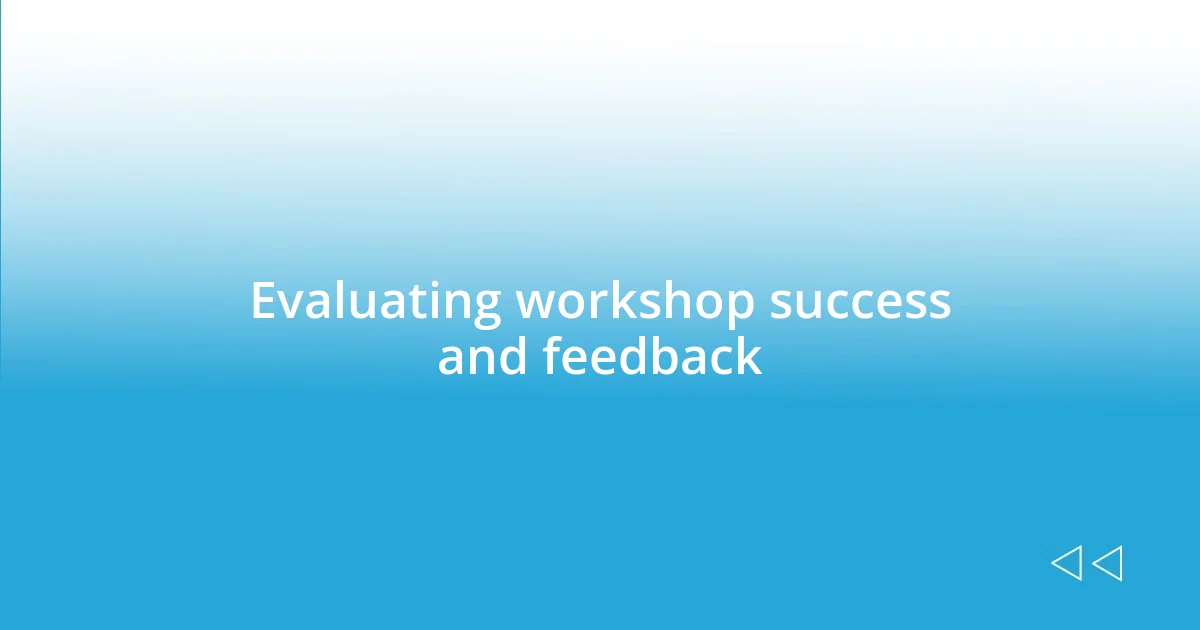Key takeaways:
- The author’s personal journey in art highlights creativity as a powerful form of communication and self-expression.
- Organizing art workshops fosters community, skill development, emotional release, and networking among participants.
- Incorporating participant feedback is crucial for evolving workshop effectiveness and ensuring a supportive environment for individual artistic growth.

My personal background in art
From a young age, art has always felt like a second language to me. I vividly remember sitting in my grandmother’s garden, surrounded by vibrant flowers, sketching their beauty in my little notebook. Those moments of pure creativity fueled my passion, and I often wondered how I could ever capture the emotion behind each petal on my paper.
As I grew older, I delved deeper into various art forms, exploring everything from painting to sculpture. I remember a particular summer spent in a local pottery workshop, where I discovered the joy of shaping clay into something tangible. The process was both frustrating and exhilarating; at times, I questioned whether I was skilled enough, but each finished piece brought a sense of accomplishment that was profoundly fulfilling.
Throughout my journey, I’ve learned that art isn’t just about aesthetics; it’s a form of communication that transcends words. I often find myself thinking: how can I evoke a feeling in someone through a simple brushstroke? This inquiry drives me to constantly hone my skills and share my experiences with others, hoping to ignite the same passion for creativity in them.

Reasons to organize art workshops
Organizing art workshops provides an incredible opportunity to foster creativity in a collaborative environment. I recall the first workshop I led, where I witnessed participants transform timid sketches into bold expressions of their inner worlds. It was a reminder that art can serve as a powerful outlet for self-expression, connecting people through shared experiences and emotional exploration.
Here are some reasons I believe organizing art workshops can be profoundly impactful:
- Community Building: Workshops bring individuals together, creating a supportive space where creativity thrives.
- Skill Development: Participants get hands-on experience, learning new techniques that enhance their artistic abilities.
- Emotional Release: Art allows for an authentic expression of feelings, helping individuals process emotions in a constructive way.
- Inspiration: Witnessing others’ artistic journeys can spark new ideas and encourage participants to explore their unique styles.
- Networking Opportunities: Workshops create a platform for artists and art enthusiasts to connect and collaborate, fostering relationships that can last a lifetime.
Every time I organize a workshop, I’m reminded of how vital these gatherings are in nurturing not only creativity but also a sense of belonging among participants. I’ve seen shy individuals bloom into confident artists, with just a little support and encouragement. It reinforces my belief that art workshops are more than just teaching; they are about creating a community that celebrates diversity in creativity.

Planning the workshop structure
Planning the structure of an art workshop requires careful consideration to foster a positive and engaging environment. I’ve learned that starting with a clear agenda helps set expectations and eases participants into the process. For example, during one workshop, I divided the time into three segments: a demonstration, hands-on practice, and a feedback session. This not only allowed participants to digest information gradually but also encouraged a community dialogue about their artworks.
Another essential element is flexibility. I vividly recall a moment when I had to adapt my planned agenda to accommodate a participant struggling with a technique. Instead of sticking rigidly to the schedule, I pivoted and offered a miniature one-on-one session within the larger group. It reminded me that creating a supportive environment is as important as any technique I could teach.
Lastly, incorporating different learning styles is crucial to reach every participant effectively. Some absorb information by watching, others by doing, and a few thrive on interaction. I ensure that my workshops include visual aids, hands-on activities, and open discussions, creating a rich tapestry of learning experiences. Balancing structure with adaptability has been my key takeaway in planning workshop structures.
| Workshop Element | Description |
|---|---|
| Clear Agenda | Sets expectations and eases participants into the process. |
| Flexibility | Ability to adjust the plan based on participant needs and interactions. |
| Learning Styles | Incorporates visual aids, hands-on activities, and discussions to engage everyone. |

Essential materials and supplies
When it comes to essential materials and supplies for art workshops, I find that having a well-stocked toolkit can make all the difference. For instance, during one workshop, I was surprised to see how a simple selection of textured papers transformed participants’ approaches to mixed media art. I remember the joy on their faces when they discovered how different materials could enhance their creativity.
I often ask myself which materials resonate most with my participants. Over time, I’ve realized that providing a variety of supplies—like paints, brushes, charcoal, and canvas—enables individuals to express themselves freely. On one occasion, I included a range of unconventional items, such as sponges and fabric, which inspired one participant to create a piece that was truly unique. It’s fascinating how the right materials can unlock hidden potentials.
Another key factor is ensuring that safety supplies are at the forefront. It’s easy to overlook things like aprons and gloves, but I’ve learned these small details matter. During a particularly vibrant painting session, I once neglected to have enough aprons on hand, which led to one participant’s shirt being splattered with paint. They laughed it off, but it reminded me that a prepared workshop creates a more comfortable and enjoyable experience for everyone involved.

Marketing your art workshops
When it comes to marketing my art workshops, I’ve discovered that authentic storytelling makes a significant impact. I remember sharing a heartfelt email with potential participants about how much art has transformed my life. Reflecting on my own journey not only draws people in but also motivates them to think about how art might enrich their own lives. Have you ever considered how your personal story could resonate with others? It’s a powerful way to connect.
Social media has been a game-changer for promoting my workshops. Platforms like Instagram and Facebook have allowed me to showcase student work and behind-the-scenes glimpses. I recall one time I posted a short video of a participant’s joyful reaction to her finished painting, which inspired quite a few new sign-ups. Visual content creates a buzz and establishes a community eager to join in the creative fun.
I’ve also learned the value of partnering with local businesses or art supply stores. By collaborating for cross-promotions or hosting events together, I widen my reach and tap into new audiences. I once co-hosted a pop-up workshop at a quaint café, and the synergy between the art and the atmosphere was electric. It made me wonder: how often do we overlook the potential of community connections? It’s a simple yet impactful strategy to elevate your marketing game.

Engaging participants effectively
Engaging participants effectively requires a thoughtful approach. I’ve learned that establishing an interactive environment is key. In one workshop, I introduced a “creative circle” where everyone shared their artistic intentions. The energy shifted instantly—participants became more invested not just in their own work, but in supporting each other. It made me realize how sharing personal stories can foster deeper connections. Have you ever seen how vulnerability opens up pathways for collaboration?
To keep everyone actively involved, I often incorporate hands-on activities that spark curiosity. I once organized a mini-challenge where participants had to create a piece using only three colors. The excitement was palpable as people experimented, often laughing at their unexpected results. It struck me that embracing constraints often leads to remarkable creativity. Isn’t it fascinating how limitations can push us to explore new horizons?
Lastly, I make it a point to celebrate all forms of expression. During one workshop, I noticed a participant hesitating to showcase her work because it deviated from traditional styles. I gently encouraged her to take center stage, and when she did, the appreciation from the group was overwhelming. That moment reiterated the importance of validation; after all, isn’t every unique expression a worthwhile addition to the artistic tapestry we’re weaving together?

Evaluating workshop success and feedback
Evaluating the success of my art workshops is something I take to heart. After each session, I always encourage participants to share feedback through a brief survey. The first time I did this, I was pleasantly surprised by the honesty and depth of their responses. It made me appreciate that what I thought was a “successful” workshop might not resonate the same way with everyone. Isn’t it interesting how a few simple questions can unveil perspectives that I might never have considered?
Incorporating constructive criticism has transformed my approach. I remember one participant noting that the pace of the workshop felt rushed during the painting phase. Initially, I felt defensive, but soon I realized she was genuinely eager to dive deeper into her technique. That kind of feedback is a golden opportunity for growth. It made me wonder—how often do we shy away from critiques that could ultimately enhance our work?
I also love celebrating the successes, big and small. After a recent workshop, I compiled a collage of participant artworks to showcase the diversity of styles and stories. Sharing this on social media not only highlighted their creativity but also made the participants feel valued. I’ve learned that recognizing achievements, even when they seem minor, fosters a sense of community. How can we create more spaces for artists to gain confidence in their unique voices?
















